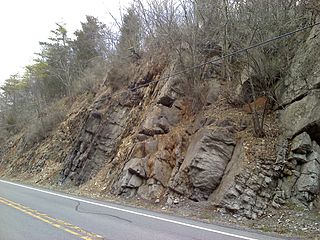 W
WThe Bertie Formation, also called Bertie Limestone and Bertie Dolomite, formerly named as Bertie Group, is a Late Silurian geologic formation and Lagerstätte in southern Ontario, Canada and western New York State, United States. The formation comprises dolomites, limestones and shales and reaches a thickness of 495 feet (151 m) in the subsurface, while in outcrop the formation can be 60 feet (18 m) thick.
 W
WThe Silurian Bloomsburg Formation is a mapped bedrock unit in Pennsylvania, New Jersey, New York and Maryland. It is named for the town of Bloomsburg, Pennsylvania in which it was first described. The Bloomsburg marked the first occurrence of red sedimentary rocks in the Appalachian Basin.
 W
WThe Brassfield Formation, named by A.F. Foerste in 1906, is a limestone and dolomite formation exposed in Arkansas, Ohio, Kentucky, Indiana, Tennessee and West Virginia in the United States. It is Early Silurian in age and well known for its abundant echinoderms, corals and stromatoporoids. In Ohio, where the unit has escaped dolomitization, the Brassfield is an encrinite biosparite with numerous crinoid species.
 W
WThe Cancañiri Formation, also named as Cancañiri Tillite, is a Katian to Hirnantian geologic formation of central Bolivia. The pebbly, argillaceous sandstones, shales and siltstones of the up to 1,500 metres (4,900 ft) thick formation, were deposited in a glacial foreshore to deep water turbiditic environment. The formation is named after Cancañiri, a mining town close to Llallagua, where a local legend of a possessed woman is believed. The formation overlies the San Benito Formation in Cochabamba and the Amutara Formation in other parts. The Cancañiri Formation is overlain by the Uncía Formation.
 W
WThe Catavi Formation is a Pridoli to Emsian geologic formation of northern and central Bolivia. The formation comprises a 456 m (1,496 ft) thick succession of fine-grained, olive to brown sandstones and siltstones, shales and black limestones deposited in a shallow to deep marine environment.
 W
WThe Grimsby Formation is a geologic formation in New York. It preserves fossils dating back to the Silurian period.
 W
WThe Late Silurian to Early Devonian Keyser Formation is a mapped limestone bedrock unit in Pennsylvania, Maryland, Virginia, and West Virginia.
 W
WThe Kirusillas Formation is a Homerian geologic formation of central Bolivia. The formation comprises black shales, overlies the Llallagua Formation and is overlain by the Pampa and Guayabillas Formations. The Kirusillas Formation is laterally equivalent to the Lipeón Formation. The formation is a potential source rock for shale oil and shale gas.
 W
WThe Lipeón Formation is a Telychian to Pridoli geologic formation of southern Bolivia and northwestern Argentina. The formation comprises sandstones and siltstones. Plant fossils comprising rhyniophytes are scattered throughout, with some abundant concentrations on micaceous bedding plains. The fossil flora is the oldest of South America. Also present were quite diverse small, irregularly branching fragments possibly the tips of algae such as Buthotrephis or Hungerfordia.
 W
WThe Llallagua Formation is a Rhuddanian to Homerian geologic formation of western Bolivia. The formation comprises siliciclastic sediments. The fossil fauna suggests a warm water, nearshore current was active allowing northern hemisphere benthos to exist in the formation.
 W
WThe Reynales Formation is a geologic formation in New York. It preserves fossils dating back to the Silurian period.
 W
WThe Silurian Shawangunk Formation is a mapped bedrock unit in eastern Pennsylvania, New Jersey, and New York. It is named for the Shawangunk Ridge for which it is the dominant rock type. The division of the Shawangunk between the Tuscarora Formation and Clinton Group has not been conclusively determined. The shift of nomenclature currently has the divide between Hawk Mountain and Lehigh Gap.
 W
WWills Creek Formation is a mapped Silurian bedrock unit in Pennsylvania, Maryland, Virginia, and West Virginia.